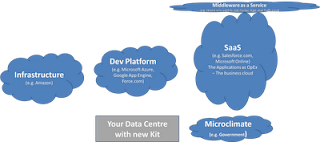Firstly though lets work out the different types and their level of reality
Infrastructure clouds
Amazon.com type thing. These are the easiest type of clouds to get you head around at first as these are really just your current data centre model just made virtual. You get a "box" you can install software on the "box" and you can start and stop the "box". The only difference is that you can also duplicate the box quickly to add more capacity and throw the unwanted boxes away without having any issues around wasted investment. Scaling is your problem but the infrastructure makes it easy.
Infrastructure clouds also have the great advantage that you can get off them at anytime and move back to your own kit or move to another provider. After all its just Linux/Windows so it really isn't anything special.
Development Platforms
These are what Google, Microsoft and Salesforce offer you. Its not an infrastructure solution in a traditional sense as they require you to develop specifically for their platform. These people give you a virtual machine and a set of vendor specific libraries. You write your application for these virtual machines (and write is the operative term) and then you deploy it, scaling is taken as being the problem of the platform provider but they might either limit you or set some sort of bugetary limit.
The key here is that these environments are just your local dev shifted to the cloud, its actually a decision to write code for someone else's environment and this means accepting that you will be locked in. Believing that you can just "unplug" yourself in these environments is very dangerous unless the provider actually gives you a route. The area of most lock-in at the moment appears to be around data access with all of the providers giving their own spin around data storage and search. If they start doing something like Java + JDBC and you can get a hibernate provider that enables you to switch more simply then the lock-in reduces. If they are using their own development language then the lock-in is near total.
Middleware as a Service
These are where smaller companies than Amazon/Google/Microsoft have seen the development platforms and thought "our middleware could do that". The offer here is that instead of having all the servers in your environment you just rent the infrastructure you need from the provider and everything is then easy.
This for me is the cirrus of the cloud world. After all what is the big problem with when you buy a big load of Middleware licenses and set up some centralised service? No bugger uses it or you get lots of people using it in millions of different ways. This is a cheap way to do the former and a more expensive way to do the later. I could be wrong about this one but on its own I think its exactly what a cloud is vapourware.
SaaS
For me this is the poster child of Cloud. Its the CapEx to OpEx converter, its the business utility and it shouts loud and proud "I do not differentiate your business I am a commodity". This is a very good thing. Whether it is Salesforce.com, Wrike or something else the whole point is saving money and turning it into an OpEx business utility.
SaaS means lock-in. But lock-in around a commodity which means its really only the data that matters and most of the SaaS providers give you a decent set of APIs so you could build your own migration to another commodity provider if you want.
Microclimates
Ok these are the real private clouds. How do you know if you have a micro-climate? Well you cease to consider it as "yours" but as an internal, or outsourced, utility. There are no flashing lights, there is no physical ownership, the only thing you care about is capacity and flexibility. Critically in a micro-climate you are billing the business in the same way as Amazon ... as a utility and based on short term consumption.
Microclimates are (IMO) a few years away in most areas with the likes of governments probably leading the way with microclimates that meet their hightened security requirements. Microclimates are only for the VERY biggest companies to do on their own and more likely should be sector specific. These micro-climates will also be dominated by applications that have dynamic scalability requirements, forecasting, web sites, intranets on pay day etc and applications will be adjusted to take advantage of that scaling, especially at the business value end. Crucially a micro-climate must be seen as a business OpEx.
Your Data centre with new kit
Don't let the hardware and software vendors fool you. Buying new hardware and a new set of provisioning tools does not make something a "cloud" it just makes it a better automated data centre.
This is the snake-oil of Cloud computing, software and hardware vendors who are claiming some magic dust that you can sprinkle on your current data centre to make it a cloud so you don't need to work with those "messy" public clouds which aren't for "proper" companies like yourself. This is hooey and just age old bandwagon jumping.
So there it is, the different worlds of cloud as I see them today.... needs a picture though.
 Spot the difference?
Spot the difference?Technorati Tags: cloud, Service Architecture
2 comments:
Where do I get a user friendly RDBMS in a cloud, which I can use and not pay for?
Nowhere? Microsoft are going to do something in this space but I'd really say that you should think carefully about whether you really want an RDBMS in the cloud or whether you should look at another model. Amazon's S3 doesn't do RDBMS for some very good scalability reasons.
Post a Comment